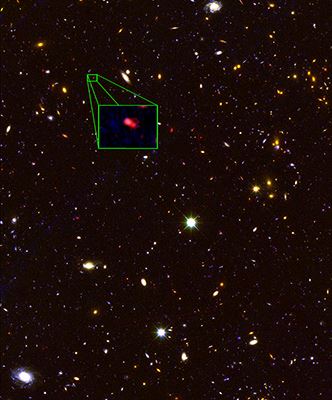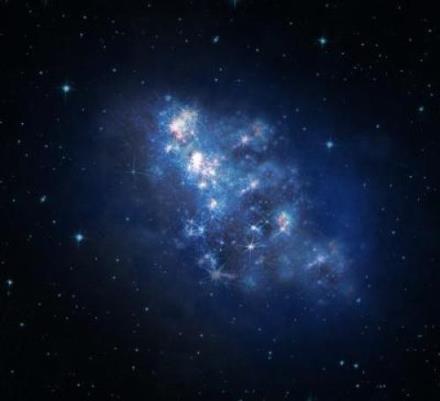Astronomy news
Astronomers discover most
distant known galaxy
23 November 2013
A team of astronomers has discovered a galaxy at a distance of 13.1
billion light years and a redshift of 7.5, and it is surprisingly
evolved for such a short time after the big bang, posing problems for
theorists.
The team from Universities of California and Texas
identified a very distant galaxy candidate using deep optical and
infrared images taken by the Hubble Space Telescope. Follow-up
observations of this galaxy by the Keck Telescope in Hawai'i confirmed
its distance.
In searching for distant galaxies, they selected
several candidates, based on their colours, from the approximately
100,000 galaxies identified in the Hubble Space Telescope images taken
as a part of the CANDELS survey, the largest project ever performed by
the Hubble Space Telescope, with a total allocated time of roughly 900
hours. However, using colours to sort galaxies is tricky because some
nearby objects can masquerade as distant galaxies.
Therefore, to measure the distance to these galaxies in a definitive
way, astronomers use spectroscopy — specifically, how much the
wavelength of a galaxy's light has shifted towards the red-end of the
spectrum as it travels from the galaxy to Earth, due to the expansion of
the universe. This phenomenon is called "redshift." Since the expansion
velocity (redshift) and distances of galaxies are proportional, the
redshift gives astronomers a measure of the distance to galaxies.

Hubble CANDELS Field Image with Galaxy z8_GND_5296

An artist's rendition of the newly discovered most
distant galaxy z8_GND_5296.
"What makes this galaxy unique, compared to other such discoveries, is
the spectroscopic confirmation of its distance," said Mobasher, a
professor of physics and observational astronomy. "By observing a galaxy
that far back in time, we can study the earliest formation of galaxies,"
he said. "By comparing properties of galaxies at different distances, we
can explore the evolution of galaxies throughout the age of the
universe."
Commenting on the research, Dr Marek Kukula, Public Astronomer at the
Royal Observatory Greenwich, said: "This, along with some other
evidence, shows that there are already quite surprisingly evolved
galaxies in the very early Universe." This poses a serious problem for
theorists because the further back we look the more primitive the
galaxies are supposed to be. Yet this, the most distant galaxy know, is
already mature at so close a time to the big bang.
The discovery was made possible by a new instrument, MOSFIRE,
commissioned on the Keck Telescope. Not only is the instrument extremely
sensitive, but it is designed to detect infrared light -- a region of
the spectrum to where the wavelength of light emitted from distant
galaxies is shifted -- and could target multiple objects at a time. It
was the latter feature that allowed the researchers to observe 43 galaxy
candidates in only two nights at Keck, and obtain higher quality
observations than previous studies.
By performing spectroscopy on these objects, researchers are able to
accurately gauge the distances of galaxies by measuring a feature from
the ubiquitous element hydrogen called the Lyman alpha transition. It is
detected in most galaxies that are seen from a time more than one
billion years from the Big Bang, but as astronomers probe earlier in
time, the hydrogen emission line, for some reason, becomes increasingly
difficult to see.
Of the 43 galaxies observed with MOSFIRE, the research team detected
this Lyman alpha feature from only one galaxy, z8-GND-5296, shifted to a
redshift of 7.5. The researchers suspect they may have zeroed in on the
era when the universe made its transition from an opaque state in which
most of the hydrogen is neutral to a translucent state in which most of
the hydrogen is ionized (called the Era of Re-ionization).
"The difficulty of detecting the hydrogen emission line does not mean
that the galaxies are absent," said Reddy, an assistant professor of
astronomy. "It could be that they are hidden from detection behind a
wall of neutral hydrogen."
The team's observations showed that z8-GND-5296 is forming stars
extremely rapidly — producing each year ~300 times the mass of our sun.
By comparison, the Milky Way forms only two to three stars per year. The
new distance record-holder lies in the same part of the sky as the
previous record-holder (redshift 7.2), which also happens to have a very
high rate of star-formation.
"So we're learning something about the distant universe," said Steven
Finkelstein at the University of Texas at Austin, who led the project.
"There are way more regions of very high star formation than we
previously thought. There must be a decent number of them if we happen
to find two in the same area of the sky."
"With the construction and commissioning of larger ground-based
telescopes — the Thirty Meter Telescope in Hawai'i and Giant Magellan
Telescope in Chile — and the 6.5 meter James Webb Space Telescope in
space, by the end of this decade we should expect to find many more such
galaxies at even larger distances, allowing us to witness the process of
galaxy formation as it happens," Mobasher said.
To top |